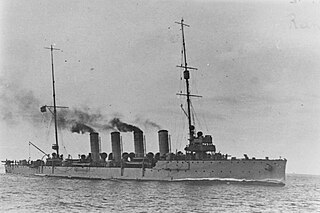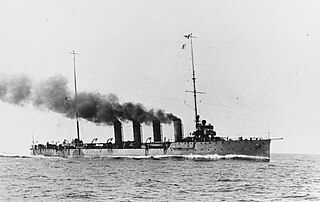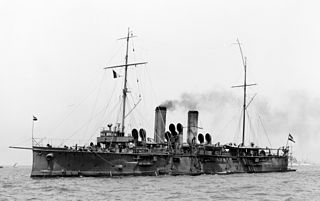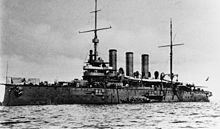
The Erzherzog Karl class was a class of pre-dreadnought battleships of the Austro-Hungarian Navy built before World War I. All of the battleships of the Erzherzog Karl-class were built in the Stabilimento Tecnico Triestino shipyards in Trieste. The first battleship, Erzherzog Karl was laid down in 1902. Construction on the remaining two battleships, Erzherzog Ferdinand Max and Erzherzog Friedrich continued up to 1905. Erzherzog Karl was commissioned in 1906, while Erzherzog Ferdinand Max and Erzherzog Friedrich were commissioned in 1907. The three Erzherzog Karl-class battleships were considered relatively modern by the time they were commissioned. However, small docking space and budget restraints resulted in the class being fairly compact. Nevertheless, they were well designed and properly protected. The Erzherzog Karl class were the last and largest pre-dreadnoughts built by the Austrian Navy. They were named after members of the Austrian Royal family.

SMS Novara was a Novara-class scout cruiser of the Austro-Hungarian Navy which served during World War I. Built by the Danubius shipyard between December 1912 and January 1915, Novara was the third and final member of her class to enter service, some six months after the start of the war. She was armed with a battery of nine 10-centimeter (3.9 in) guns and had a top speed of 27 knots.

SMS Kaiserin und Königin Maria Theresia was an armored cruiser used by the imperial Austro-Hungarian Navy from 1895 to 1917; she was the first ship of that type built by the Austro-Hungarian Navy. The ship was a unique design, built by the Stabilimento Tecnico Triestino shipyard in Trieste; she was laid down in July 1891, launched in April 1893, and completed in November 1894. Armed with a main battery of two 24-centimeter (9.4 in) guns and eight 15 cm (5.9 in) guns, the ship provided the basis for two subsequent armored cruiser designs for the Austro-Hungarian Navy.

SMS Erzherzog Karl was a pre-dreadnought battleship built by the Austro-Hungarian navy in 1902. The lead ship of the Erzherzog Karl class, she was launched on 3 October 1903. They were assigned to the III Battleship Division.

SMS Erzherzog Ferdinand Max was a pre-dreadnought battleship built by the Austro-Hungarian Navy in 1902. The second ship of the Erzherzog Karl class, she was launched on 21 May 1905. She was assigned to the III Battleship Division.

SMS Erzherzog Friedrich was a pre-dreadnought battleship built by the Austro-Hungarian Navy in 1902. The second ship of the Erzherzog Karl class, she was launched on 30 April 1904. She was assigned to the III Battleship Division.

SMS Budapest was a Monarch-class coastal defense ship built for the Austro-Hungarian Navy in the 1890s. After their commissioning, Budapest and the two other Monarch-class ships made several training cruises in the Mediterranean Sea in the early 1900s. Budapest and her sisters formed the 1st Capital Ship Division of the Austro-Hungarian Navy until they were replaced by the newly commissioned Habsburg-class pre-dreadnought battleships at the turn of the century. In 1906 the three Monarchs were placed in reserve and only recommissioned during the annual summer training exercises. After the start of World War I, Budapest was recommissioned and assigned to 5th Division together with her sisters.

SMS Kaiser Karl VI was the second of three armored cruisers built by the Austro-Hungarian Navy. She was built by the Stabilimento Tecnico Triestino in Trieste between June 1896 and May 1900, when she was commissioned into the fleet. Kaiser Karl VI represented a significant improvement over the preceding design—Kaiserin und Königin Maria Theresia—being faster and more heavily armed and armored. She provided the basis for the third design, Sankt Georg, which featured further incremental improvements. Having no overseas colonies to patrol, Austria-Hungary built the ship solely to reinforce its battle fleet.

SMS Saida was a Novara-class scout cruiser built for the Austro-Hungarian Navy in the early 1910s. The ship was armed with a main battery of nine 10 cm (3.9 in) guns, and six twin 53.3 cm (21.0 in) torpedo tubes were added in 1917. She was built by the Cantiere Navale Triestino shipyard from 1911 to 1914, entering service days after the outbreak of World War I. She spent the war as a flotilla leader, conducting raids and patrols in the narrow waters of the Adriatic Sea.

SMS Kronprinz Erzherzog Rudolf was a unique ironclad warship built for the Austro-Hungarian Navy in the 1880s. The last ironclad completed for the Austro-Hungarian Navy, Kronprinz Erzherzog Rudolf was laid down in January 1884, launched in July 1887, and completed in September 1889. She was armed with a main battery of three 30.5-centimeter (12 in) guns and had compound steel plating of the same thickness on her armored belt. The ship had an uneventful career, in large part due to her rapid obsolescence. She made trips to foreign countries to represent Austria-Hungary, but was reduced to a coastal defense ship by 1906. She continued in this role through World War I, based at Cattaro Bay, where her crew took part in the Cattaro Mutiny in early 1918. After the war, Kronprinz Erzherzog Rudolf was transferred to the Navy of the Kingdom of Serbs, Croats and Slovenes, renamed Kumbor and classed as a coastal defence ship, but she remained in their inventory for only a year, being sold for scrap in 1922.

SMS Aspern was the second of the three Zenta-class cruisers built for the Austro-Hungarian Navy in the 1890s. The class included two other vessels, Zenta and Szigetvár. The Zentas were intended to serve as fleet scouts and to guard the battleships against attacks by torpedo boats. They carried a main battery of eight 12 cm (4.7 in) guns manufactured by Škoda; Aspern and her sisters were the first major warships of the Austro-Hungarian fleet to be armed entirely with domestically produced guns. Unlike earlier Austro-Hungarian cruisers, the Zenta class discarded heavy belt armor in favor of a higher top speed.

SMS Szigetvár was a protected cruiser of the Zenta class, the third and final member of her class, which was built for the Austro-Hungarian Navy in the late 1890s. The class included two other vessels, Zenta and Aspern. The Zentas were intended to serve as fleet scouts and to guard the battleships against attacks by torpedo boats. They carried a main battery of eight 12 cm (4.7 in) guns manufactured by Škoda; Szigetvár and her sisters were the first major warships of the Austro-Hungarian fleet to be armed entirely with domestically produced guns. Unlike earlier Austro-Hungarian cruisers, the Zenta class discarded heavy belt armor in favor of a higher top speed.

The Novara class was a class of three scout cruisers built for the Austro-Hungarian Navy. Named for the Battle of Novara, the class comprised SMS Saida, SMS Helgoland, and SMS Novara. Construction started on the ships shortly before World War I; Saida and Helgoland were both laid down in 1911, Novara followed in 1912. Two of the three warships were built in the Ganz-Danubius shipyard in Fiume; Saida was built in the Cantiere Navale Triestino shipyard in Monfalcone. The Novara-class ships hold the distinction for being the last cruisers constructed by the Austro-Hungarian Navy.

The Kaiser Franz Joseph I class was a class of two protected cruisers built for the Austro-Hungarian Navy. Named for Austro-Hungarian Emperor Franz Joseph I, the class comprised SMS Kaiser Franz Joseph I and SMS Kaiserin Elisabeth. Construction took place throughout the late 1880s, with both ships being laid down in 1888. Kaiser Franz Joseph I was built by Stabilimento Tecnico Triestino in Trieste, while Kaiserin Elisabeth was built at the Pola Navy Yard in Pola. The Kaiser Franz Joseph I-class ships were the first protected cruisers constructed by the Austro-Hungarian Navy. Kaiser Franz Joseph I was the first ship of the class to be commissioned into the fleet in July 1890. She was followed by Kaiserin Elisabeth in November 1892.

SMS Kaiser Franz Joseph I was a protected cruiser built for the Austro-Hungarian Navy. Named for the Austrian emperor and Hungarian king Franz Joseph I, Kaiser Franz Joseph I was the lead ship of her namesake class. Constructed by Stabilimento Tecnico Triestino in Trieste, she was laid down in January 1888 and launched in May 1889. Kaiser Franz Joseph I was commissioned into the Navy in June 1890. As the first protected cruiser constructed by the Austro-Hungarian Navy, she was intended to serve as Austria-Hungary's response to the Italian cruisers Giovanni Bausan and Etna. Her design was heavily influenced by the Jeune École, a naval strategy which had gained prominence in the 1880s as a means to combat a larger and more heavily armored navy of battleships through the use of torpedo flotillas.

SMS Orjen was one of six Tátra-class destroyers built for the kaiserliche und königliche Kriegsmarine shortly before the First World War. Completed in 1914, she helped to sink an Italian destroyer during the action off Vieste in May 1915 after Italy declared war on Austria-Hungary. Two months later the ship participated in an unsuccessful attempt to recapture a small island in the central Adriatic Sea from the Italians. In November and early December Orjen was one of the ships conducting raids off the Albanian coast to interdict the supply lines between Italy and Albania, although she did not participate in the First Battle of Durazzo in late December. Orjen participated in several raids on the Otranto Barrage in 1916–1917 with limited success. She was transferred to Italy in 1920 in accordance with the peace treaties ending the war and renamed Pola. She mostly served as a training ship or in Italian North Africa when she was not in reserve from 1924 to 1928. Renamed Zenson in 1931, the ship was scrapped in 1937.

SMS Csepel was one of six Tátra-class destroyers built for the kaiserliche und königliche Kriegsmarine shortly before the First World War. Completed in 1913, she helped to sink an Italian destroyer during the action off Vieste in May 1915 after Italy declared war on Austria-Hungary. Two months later the ship participated in an unsuccessful attempt to recapture a small island in the central Adriatic Sea from the Italians. In November and early December Csepel was one of the ships conducting raids off the Albanian coast to interdict the supply lines between Italy and Albania. She was hit one time during the First Battle of Durazzo in late December. Her stern was blown off by a French submarine in early 1916 and her repairs were not completed until early 1917.

SMS Balaton was one of six Tátra-class destroyers built for the kaiserliche und königliche Kriegsmarine shortly before the First World War. Completed in 1913, she did not participate in the attacks on the Italian mainland after Italy declared war on Austria-Hungary in May 1915. Two months later the ship bombarded a small island in the Central Adriatic Sea during an unsuccessful attempt to recapture it from the Italians. In November and early December Balaton was one of the ships conducting raids off the Albanian coast to interdict the supply lines between Italy and Albania. She played a minor role in the 1st Battle of Durazzo in late December. Balaton participated in several unsuccessful raids on the Otranto Barrage in 1917, although she sank an ammunition ship during the Battle of the Strait of Otranto. She was transferred to Italy in 1920 in accordance with the peace treaties ending the war and renamed Zenson. The Regia Marina used her for spare parts; she was discarded in 1923 and subsequently scrapped.

SMS Tátra was the lead ship of her class of six destroyers built for the kaiserliche und königliche Kriegsmarine shortly before the First World War. Completed in 1913, she helped to sink an Italian destroyer during the action off Vieste in May 1915 after Italy declared war on Austria-Hungary. Two months later the ship participated in an unsuccessful attempt to recapture a small island in the Central Adriatic Sea from the Italians. In November and early December Tátra was one of the ships conducting raids off the Albanian coast to interdict the supply lines between Italy and Albania. During the early stages of the 1st Battle of Durazzo in late December, the ship was tasked to tow her one of her sister ships that had been crippled by a mine. She was forced to abandon her sister when the Austro-Hungarians were spotted by a strong force of Allied ships and had to evade their pursuit. Tátra participated in several unsuccessful raids on the Otranto Barrage in 1917. She was transferred to Italy in 1920 in accordance with the peace treaties ending the war and renamed Fasana. The Regia Marina used her for spare parts; she was discarded in 1923 and subsequently scrapped.



















